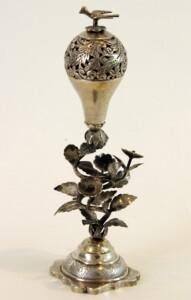TIOH Art Tour: Silver Spice Container

Spice Container a
- Poland, c. 1850
- Silver with silver filigree
- Gift of the Briskin Family
Spice Container b
- Poland or Ukraine, c. 1800
- Formerly in the collection of Michael Steinhardt
- Gift of the Briskin Family
The ritual at the close of Shabbat uses a number of symbolic objects to mark the separation between Shabbat and the rest of the week. Among these is the spice box, which holds aromatic herbs as a blessing is said over them. The lingering aroma bids a sweet goodbye to Shabbat.

This Polish spice box (a) evokes the cityscape one might have seen in the cities of Eastern Europe during the 18th and 19th centuries. With its 5 flying flags, and a small door in the front to place the spices, the silver filigree stands 12.7 inches high. The four bells remind us of the bells on the hem of the High Priest when the Temple stood in Jerusalem.
This Polish or Ukrainian spice box (b) is reminiscent of an upside-down pear that hangs from a tree with a bird perched on its top. The leaves and flowers of the tree form its base. When we use this spice box to end Shabbat, we enter a forest. We turn the perched bird and open the pear to place spices within its container. This mystical experience on earth brings us a taste of the messianic time echoing the awe of nature.
Home